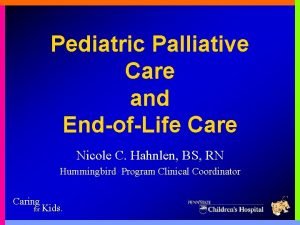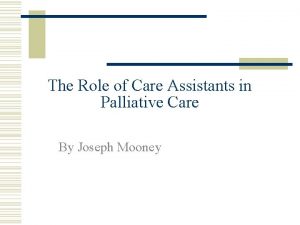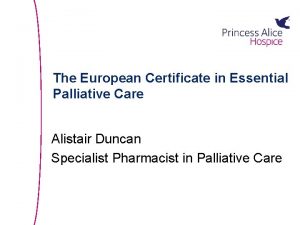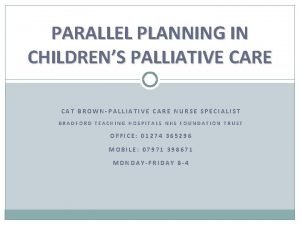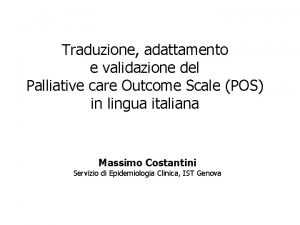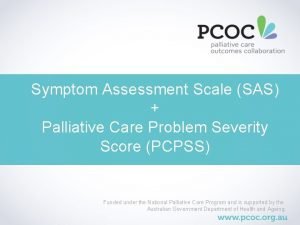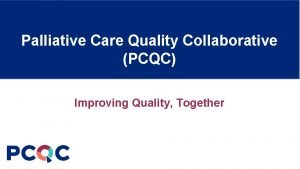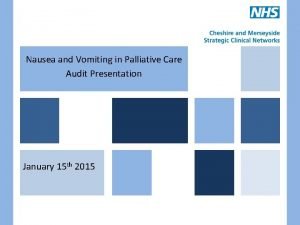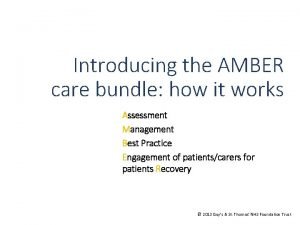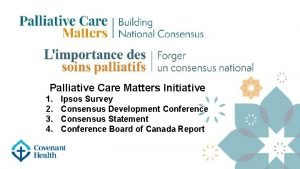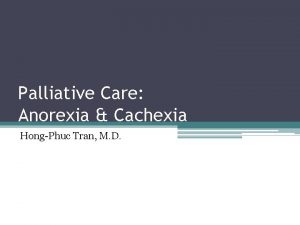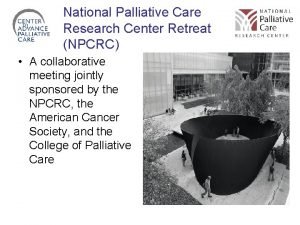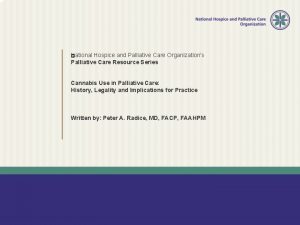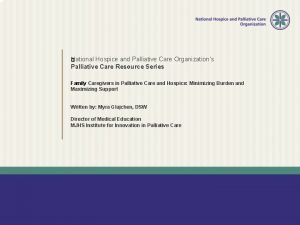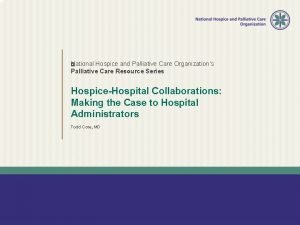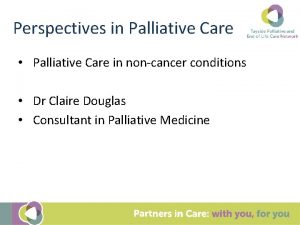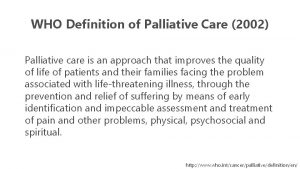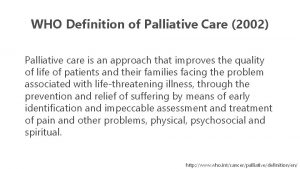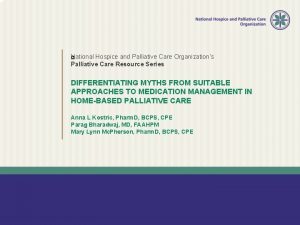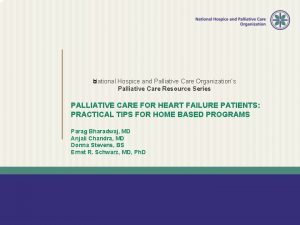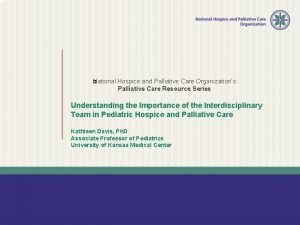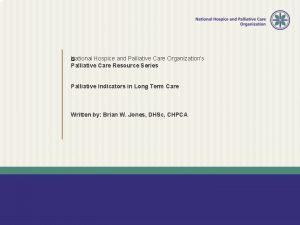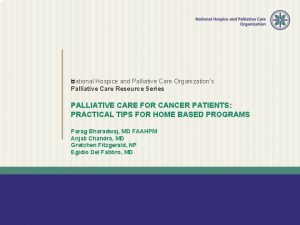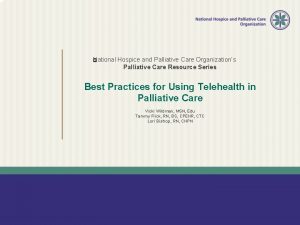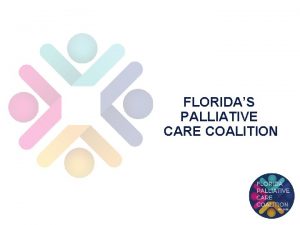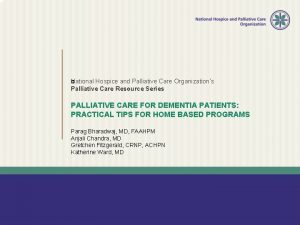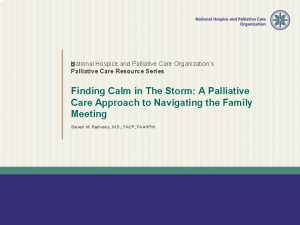NAVIGATING THE JOURNEY HOME PALLIATIVE CARE HOME NURSING
























- Slides: 24

NAVIGATING THE JOURNEY HOME: PALLIATIVE CARE, HOME NURSING AND HOSPICE CAROL MAY RN, MSN, MBA, CHPPN SUPPORTIVE CARE PROGRAM CHILDREN’S HOSPITAL OF PITTSBURGH OF UPMC

OBJECTIVES • Discus the differences between pediatric palliative care and hospice care • Increase knowledge on the differences between pediatric and adult end of life care • Describe the resources available for caregivers and parents

WHAT IS PEDIATRIC PALLIATIVE CARE? • Palliative care for children is the active total care of the child’s body, mind • • and spirit, involves giving support to the family. It begins when illness is diagnosed, and continues regardless of whether or not a child receives treatment directed at the disease. Health providers must evaluate and alleviate a child’s physical, psychological and social distress. Effective palliative care requires a broad multidisciplinary approach that includes the family and makes use of available community resources; it can be successfully implemented even if resources are limited. It can be provided in tertiary care facilities, in the community health centers and even in the children’s home. (WHO, 1998)

Psychological Physical Anxiety Depression Enjoyment/Leisure Pain Distress Happiness Fear Cognition/Attention Functional Ability Strength/Fatigue Sleep & Rest Nausea Appetite Constipation Pain Quality of Life Social Spiritual Financial Burden Caregiver Burden Roles and Relationships Affection/Sexual Function Appearance Hope Suffering Meaning of Pain Religiosity Transcendence Adapted from Ferrell, et al. 1991

Applicability of Palliative Care Bereavement Care Therapy to Modify Disease Palliative Care Therapy to Relieve Suffering and/or Improve Quality of Life Presentation/ Diagnosis Acute Illness Chronic Death Advanced Life-threatening

DEMOGRAPHICS • 53, 000 US children between 0 -19 years die each year • Infants < 1 year account for half • 75 -85% of children die in the hospital – many in intensive care • 900, 000 birth tragedies/year • Institute of Medicine, 2003

DISTINCTION BETWEEN ADULT AND PEDIATRIC PALLIATIVE CARE • Impact of childhood illness and death • • Death of a child is a “tragedy” Scientific and technological Children survive many near death crises due to advanced critical care. Technology has increased viability for births, but has increased neonatal deaths.

DISTINCTION BETWEEN ADULT AND PEDIATRIC PALLIATIVE CARE • Developmental level of the child • Child’s ability to communicate and understand affects how care providers speak, examine, assess and provide support. • • Must use family centered approach to care. Children’s understanding of death is influenced by their developmental level, past experiences and culture.

DEATH AND DYING IN AMERICA • Disparity between the way children die, and the way they want to be cared for: • • Not natural for a child to die before a parent Child and family fears abandon from health care providers Families are uncertain how to provide physical care and adjust to role changes. Transition of care • • • Who knows the child best Who can participate in developing the transition plan Communication amongst providers

DEATH AND DYING IN AMERICA • Death of a child ripples through a community, effecting many groups, friends, children and organizations. • • Families often drain their life savings to cover costs of care Grandparents grieve the loss of grandchild and the loss experienced by their child.

WHO CAN BENEFIT FROM PEDIATRIC PALLIATIVE CARE ? • Life threatening conditions for which cure may be possible but treatment may fail – Cancer • Conditions where intensive treatment may prolong life but premature death is likely to occur – Duchene muscular dystrophy

WHO CAN BENEFIT FROM PEDIATRIC PALLIATIVE CARE? • Progressive life limiting conditions with no available life prolonging treatment – Chromosomal abnormality • Conditions that are stable but secondary complications increase risk for death – Severe cerebral palsy

GENERAL PRINCIPLES OF HOSPICE AND PALLIATIVE CARE FOR CHILDREN • Precepts of palliative care for children • • • Child and family as unit of care Attention to physical, psychological, social and spiritual needs Interdisciplinary team approach Education and support of child and family Extends across illnesses and settings Bereavement support

HOW THE DEATH IS DIFFERENT • Pain modalities • • PCA or IV therapy Still SL route • Symptoms • • Less delirium with younger children Pay attention to the terminal secretions • Physical changes • • Less mottling Urination

IMMEDIATE GOALS • Improve pain and symptom management and end of life care for children with life threatening illness • Empower families to care for children in their last days of life at home • Provide education to staff, physicians and orientation programs • Establish affiliations with local hospices

COMMUNICATION • Crucial to palliative care • Chronic illness is a family experience • Communication is a major area of need • Imparting necessary information so that child and family make informed decisions • Requires interdisciplinary collaboration

RESPONDING TO ETHICAL ISSUES • Ethical issues are inevitable in end-of-life care. • Ethical issues are profoundly influenced by values, religion, culture, etc. (Davies, et. al. , 1998) • End-of-life care raises questions about meaning: • Dependency, pain and suffering • Conflicts prevented by good communication and shared decision making

BENEFITS OF A PARTNERSHIP (HOME CARE) • Understand the unique care needs of the patient • Understand the family dynamics • Understand the stressors in the home • Can share how the child responds to different types of care

BENEFITS OF A PARTNERSHIP (PC) • Knowledge of specific hospice and palliative care services • Introduce services in hospital to decrease child and family's anxiety of new service • Assist in role transition for family • Educate Home care nurses on the benefit of hospice or home based PC for the patient and family • Education to hospice staff that has a higher percentage of adult patients • Nurses, volunteers, social work

BENEFITS OF A PARTNERSHIP (HOSPICE) • Increase comfort level of staff with medications and treatment plans • • Participation in hospital's interdisciplinary rounds Consistent treatment plans increase comfort level and exposure to pediatric dosages • Interdisciplinary cooperation • Consistent reporting and descriptions to the child and family about what to expect

BENEFITS OR PARTNERSHIP • Bereavement plan started in hospital • • Grief assessment completed by palliative care team and relayed to hospice staff Develop joint bereavement groups • Hospice staff familiar with history • Report given by a team that has already provided care

BENEFITS OF PARTNERSHIP • Hospice introduced to family while inpatient and starts to build rapport • Participation in family meetings while planning discharge • Both palliative care and hospice cares for patient at home • • Parents do not have feeling of abandonment from health care institution Hospice staff has pediatric resource

SUCCESSFUL! • Orders are shared amongst all • Everyone in the home is communicating the same message • Patient, family and home care staff feels supported • Grief and bereavement services are provided to family AND home care staff

• Never be afraid to try something new, amateurs built the Ark, professionals built the Titanic. • -Anonymous
 Barry laird
Barry laird Palliative care vs hospice care
Palliative care vs hospice care Esas-r tool
Esas-r tool Akps score
Akps score Palliative care programme
Palliative care programme Principles of palliative care
Principles of palliative care Palliative care in nepal
Palliative care in nepal Palliative care assistant
Palliative care assistant European certificate in essential palliative care
European certificate in essential palliative care Parallel planning palliative care
Parallel planning palliative care Franciscan hospice and palliative care
Franciscan hospice and palliative care Hospice traduzione
Hospice traduzione Symptom assessment scale palliative care
Symptom assessment scale palliative care Pcqc registry
Pcqc registry Antiemetic ladder
Antiemetic ladder Just in case bag palliative care
Just in case bag palliative care What is amber care
What is amber care Goscote palliative care centre
Goscote palliative care centre Bluegrass palliative care
Bluegrass palliative care Calvary palliative care kogarah
Calvary palliative care kogarah Anorexia palliative care
Anorexia palliative care Palliative care matters
Palliative care matters Dr hong-phuc tran
Dr hong-phuc tran Goc palliative care
Goc palliative care National palliative care research center
National palliative care research center





